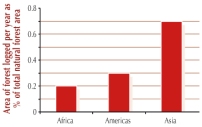

Although human activities have been reducing the world’s tropical forest area for centuries, the process accelerated to alarming rates in the latter half of the twentieth century (Roper and Roberts 1999). Deforestation is a complex issue with multiple causes, but commercial logging is a major driver in the tropics, where the greatest complement of the earth’s terrestrial biodiversity occurs. The forests of Asia in particular have suffered from unsustainable forestry practices, with 0.7% of the remaining natural forest lost to logging each year, much of it clear-felled (see figure; FAO 1997).
In parts of Malaysia and Indonesia, many forests that have already been selectively logged will be logged for the second or third time in the near future, because there is so little primary forest left. In Sabah and Peninsular Malaysia, all primary rainforest outside conservation areas has effectively been lost. As deforestation continues, previously continuous tropical forests come to consist of protected fragments scattered across a mainly agricultural landscape (Schelhas and Greenberg 1996). This is already the situation in a number of countries, such as the Philippines, Costa Rica and Ghana. This degree of habitat loss, degradation and fragmentation has serious consequences for birds.
References
Compiled: 2004
Recommended Citation:
BirdLife International (2004)
The forests of Asia, in particular, have suffered from unsustainable forestry practices.
Downloaded from https://datazone.birdlife.org/sowb/casestudy/the-forests-of-asia-in-particular-have-suffered-from-unsustainable-forestry-practices on 22/11/2024